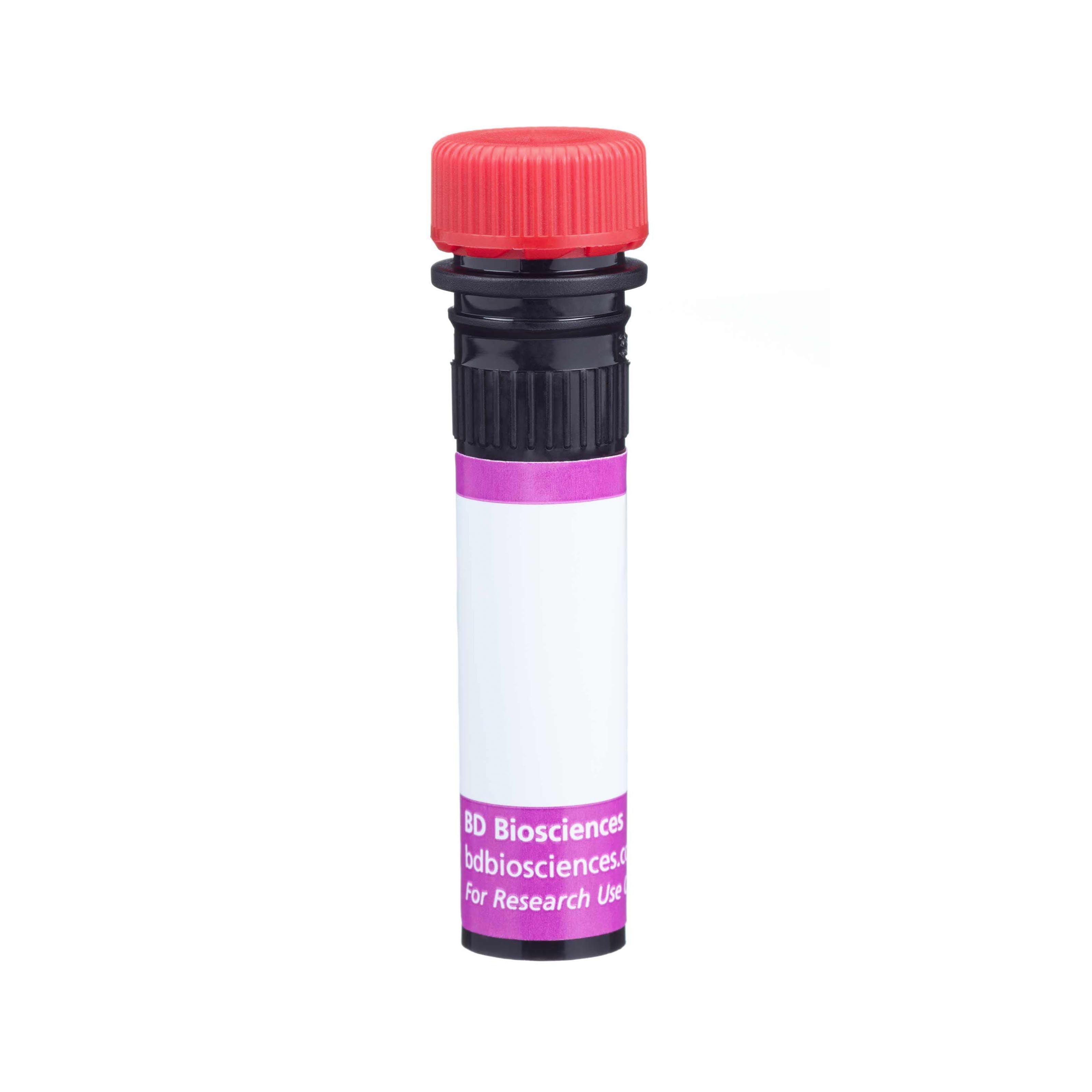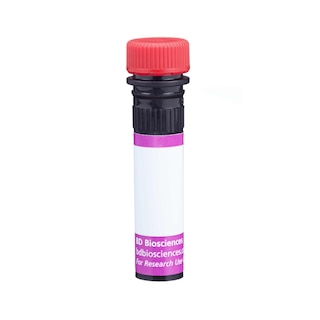-
Your selected country is
Middle East / Africa
- Change country/language
Old Browser
This page has been recently translated and is available in French now.
Looks like you're visiting us from {countryName}.
Would you like to stay on the current country site or be switched to your country?




Two-color flow cytometric analysis of CD127 expression on mouse splenocytes. Mouse splenic leucocytes were preincubated with Purified Rat Anti-Mouse CD16/CD32 antibody (Mouse BD Fc Block™) (Cat. No. 553141/553142). The cells were then stained with PE Hamster Anti-Mouse CD3e antibody (Cat. No. 553064/553063/561824) and either BD Horizon™ BV711 Rat IgG2b, κ Isotype Control (Cat. No. 563045; Left Panel) or BD Horizon BV711 Rat Anti-Mouse CD127 antibody (Cat. No. 565490; Right Panel). Two-color flow cytometric contour plots showing the correlated expression of CD127 (or Ig Isotype control staining) versus CD3e were derived from gated events with the forward and side light-scatter characteristics of viable leucocytes. Flow cytometric analysis was performed using a BD™ LSR II Flow Cytometer System.


BD Horizon™ BV711 Rat Anti-Mouse CD127

Regulatory Status Legend
Any use of products other than the permitted use without the express written authorization of Becton, Dickinson and Company is strictly prohibited.
Preparation And Storage
Recommended Assay Procedures
For optimal and reproducible results, BD Horizon Brilliant™ Stain Buffer should be used anytime BD Horizon Brilliant™ dyes are used in a multicolor flow cytometry panel. Fluorescent dye interactions may cause staining artifacts which may affect data interpretation. The BD Horizon Brilliant Stain Buffer was designed to minimize these interactions. When BD Horizon Brilliant Stain Buffer is used in in the multicolor panel, it should also be used in the corresponding compensation controls for all dyes to achieve the most accurate compensation. For the most accurate compensation, compensation controls created with either cells or beads should be exposed to BD Horizon Brilliant Stain Buffer for the same length of time as the corresponding multicolor panel. More information can be found in the Technical Data Sheet of the BD Horizon Brilliant Stain Buffer (Cat. No. 563794/566349) or the BD Horizon Brilliant Stain Buffer Plus (Cat. No. 566385).
Product Notices
- Since applications vary, each investigator should titrate the reagent to obtain optimal results.
- An isotype control should be used at the same concentration as the antibody of interest.
- Source of all serum proteins is from USDA inspected abattoirs located in the United States.
- Caution: Sodium azide yields highly toxic hydrazoic acid under acidic conditions. Dilute azide compounds in running water before discarding to avoid accumulation of potentially explosive deposits in plumbing.
- Alexa Fluor® is a registered trademark of Molecular Probes, Inc., Eugene, OR.
- For fluorochrome spectra and suitable instrument settings, please refer to our Multicolor Flow Cytometry web page at www.bdbiosciences.com/colors.
- Cy is a trademark of GE Healthcare.
- BD Horizon Brilliant Violet 711 is covered by one or more of the following US patents: 8,110,673; 8,158,444; 8,227,187; 8,455,613; 8,575,303; 8,354,239.
- BD Horizon Brilliant Stain Buffer is covered by one or more of the following US patents: 8,110,673; 8,158,444; 8,575,303; 8,354,239.
- Please refer to www.bdbiosciences.com/us/s/resources for technical protocols.
Companion Products






The SB/199 monoclonal antibody specifically binds to mouse CD127 which is also known as, the Interleukin-7 Receptor alpha chain (IL-7Rα). CD127 associates with CD132 (common γ chain) to form a high-affinity signaling IL-7R complex that mediates the biological effects of IL-7. CD127 can also complex with the Thymic Stromal Lymphopoietin Receptor (TSLPR) subunit to bind and mediate cellular responses to TSLP. CD127 is a 65-75 kDa type-I transmembrane protein that belongs to the hematopoietin receptor and the Ig gene superfamilies. Mice lacking CD127 display profoundly impaired development of the B and T lymphoid cell lineages, but display no obvious nonlymphoid abnormalities. IL-7Rα is expressed on common lymphoid progenitors and early stages of B lineage development in the bone marrow, on the earliest thymocyte progenitors, on CD4-CD8- double-negative and CD4+ and CD8+ single-positive thymocytes, and on most peripheral T lymphocytes. Intestinal intraepithelial lymphocytes with low-density γδ TCR expression upregulate CD127 expression in response to IL-2, which may be secreted by neighboring αβ TCR+ T cells.

Development References (15)
-
Akashi K, Kondo M, Weissman IL. Role of interleukin-7 in T-cell development from hematopoietic stem cells. Immunol Rev. 1998; 165:13-28. (Biology). View Reference
-
Borghesi LA, Yamashita Y, Kincade PW. Heparan sulfate proteoglycans mediate interleukin-7-dependent B lymphopoiesis. Blood. 1999; 93(1):140-148. (Biology). View Reference
-
Brown VI, Hulitt J, Fish J, et al. Thymic stromal-derived lymphopoietin induces proliferation of pre-B leukemia and antagonizes mTOR inhibitors, suggesting a role for interleukin-7Ralpha signaling.. Cancer Res. 2007; 67(20):9963-70. (Biology). View Reference
-
Brugnera E, Bhandoola A, Cibotti R, et al. Coreceptor reversal in the thymus: signaled CD4+8+ thymocytes initially terminate CD8 transcription even when differentiating into CD8+ T cells. Immunity. 2000; 13(1):59-71. (Biology). View Reference
-
Faust EA, Saffran DC, Toksoz D, Williams DA, Witte ON. Distinctive growth requirements and gene expression patterns distinguish progenitor B cells from pre-B cells. J Exp Med. 1993; 177(4):915-923. (Biology). View Reference
-
Fujihashi K, Kawabata S, Hiroi T, et al. Interleukin 2 (IL-2) and interleukin 7 (IL-7) reciprocally induce IL-7 and IL-2 receptors on gamma delta T-cell receptor-positive intraepithelial lymphocytes. Proc Natl Acad Sci U S A. 1996; 93(8):3613-3618. (Biology). View Reference
-
Goodwin RG, Friend D, Ziegler SF et al. Cloning of the human and murine interleukin-7 receptors: demonstration of a soluble form and homology to a new receptor superfamily. Cell. 1990; 60(6):941-951. (Biology). View Reference
-
Henderson AJ, Narayanan R, Collins L, Dorshkind K. Status of kappa L chain gene rearrangements and c-kit and IL-7 receptor expression in stromal cell-dependent pre-B cells. J Immunol. 1992; 149(6):1973-1979. (Biology). View Reference
-
Hozumi K, Kondo M, Nozaki H, et al. Implication of the common gamma chain of the IL-7 receptor in intrathymic development of pro-T cells. Int Immunol. 1994; 6(9):1451-1454. (Biology). View Reference
-
Kouro T, Kumar V, Kincade PW. Relationships between early B- and NK-lineage lymphocyte precursors in bone marrow. Blood. 2002; 100(10):3672-3680. (Clone-specific: Flow cytometry, Fluorescence activated cell sorting). View Reference
-
Noguchi M, Nakamura Y, Russell SM, et al. Interleukin-2 receptor gamma chain: a functional component of the interleukin-7 receptor. Science. 1993; 262(5141):1877-1880. (Biology). View Reference
-
Park LS, Martin U, Garka K, et al. Cloning of the murine thymic stromal lymphopoietin (TSLP) receptor: Formation of a functional heteromeric complex requires interleukin 7 receptor. J Exp Med. 2000; 192(5):659-670. (Biology). View Reference
-
Peschon JJ, Morrissey PJ, Grabstein KH, et al. Early lymphocyte expansion is severely impaired in interleukin 7 receptor-deficient mice. J Exp Med. 1994; 180(5):1955-1960. (Biology). View Reference
-
Sudo T, Nishikawa S, Ohno N, et al. Expression and function of the interleukin 7 receptor in murine lymphocytes. Proc Natl Acad Sci U S A. 1993; 90(19):9125-9129. (Biology). View Reference
-
Yamashita Y, Oritani K, Miyoshi EK, Wall R, Bernfield M, Kincade PW. Syndecan-4 is expressed by B lineage lymphocytes and can transmit a signal for formation of dendritic processes. J Immunol. 1999; 162(10):5940-5948. (Clone-specific: Flow cytometry). View Reference
Please refer to Support Documents for Quality Certificates
Global - Refer to manufacturer's instructions for use and related User Manuals and Technical data sheets before using this products as described
Comparisons, where applicable, are made against older BD Technology, manual methods or are general performance claims. Comparisons are not made against non-BD technologies, unless otherwise noted.
For Research Use Only. Not for use in diagnostic or therapeutic procedures.
Report a Site Issue
This form is intended to help us improve our website experience. For other support, please visit our Contact Us page.